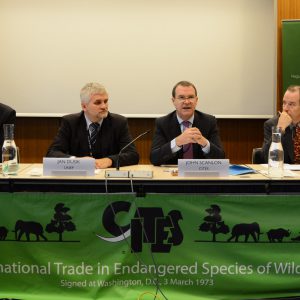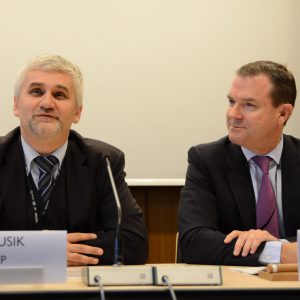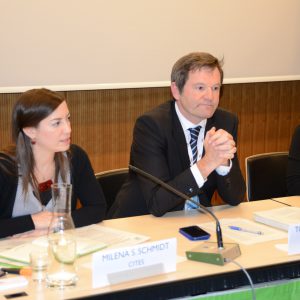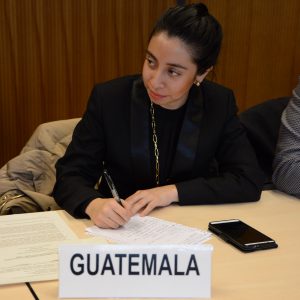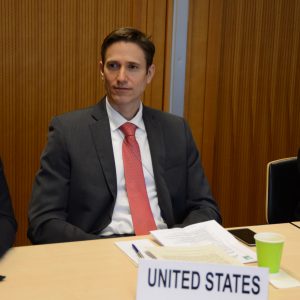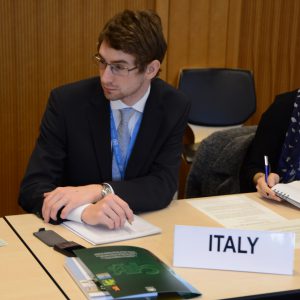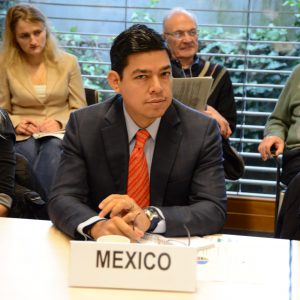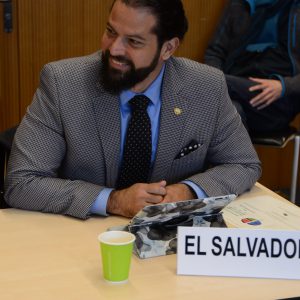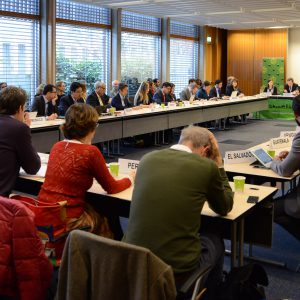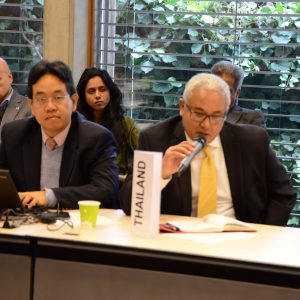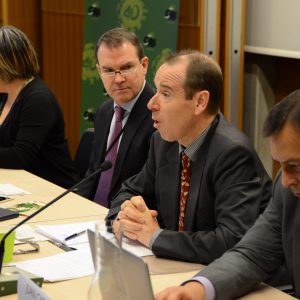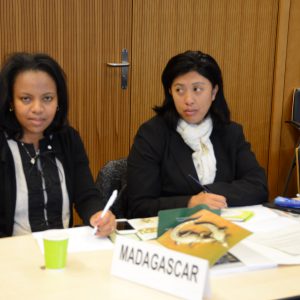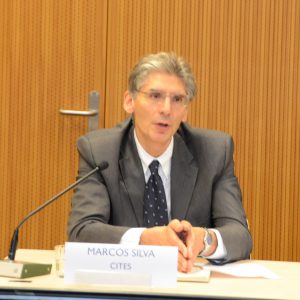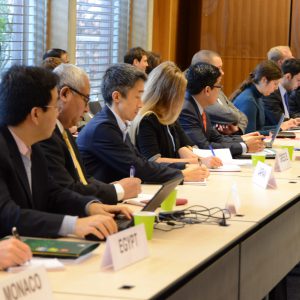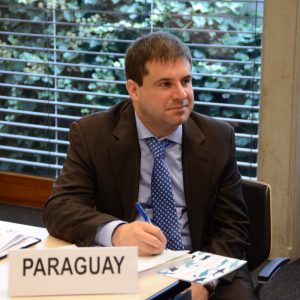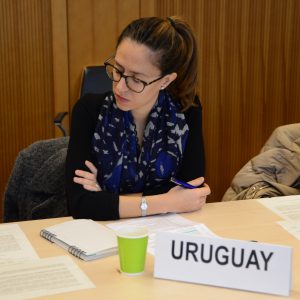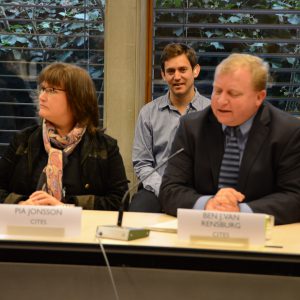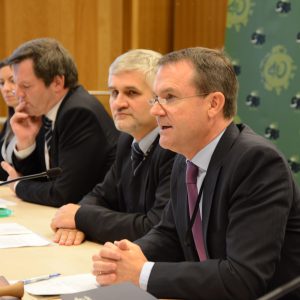Event
Briefing on the 66th meeting of the CITES Standing Committee

04 Dec 2015
10:00–12:00
Organization: Geneva Environment Network
Elephants, rhinos, tigers, rosewood, cheetahs, pangolins, & sharks as well as illegal trade in wildlife, financing, compliance issues and more all on the agenda.
A briefing on the matters to be addressed by the 181 Parties to CITES at 66th meeting of the Standing Committee (SC66) of the Convention on International Trade in Endangered Species of Wild Fauna And Flora (CITES), organized within the framework of the Geneva Environment Network, took place at the International Environment House II, on Friday 4 December 2015. (Notification to the parties available online)
SC66 will take place in Geneva, from 11 to 15 January 2016 and is likely to attract up to 400 participants. It will be the final substantive meeting of the Standing Committee before the 17th meeting of the Conference of the Parties to CITES, to be held in Johannesburg, South Africa from 24 September to 5 October 2016.
Briefing participants were also updated on the outcomes of the twenty-eighth meeting of the Animals Committee (AC28) held in Tel Aviv, Israel, from 30 August to 3 September 2015 and the twenty-second meeting of the Plants Committee (PC22) which took place in Tbilisi, Georgia, from 19 to 23 October 2015. Many of the results of these meetings feed into SC66.
Agenda
10:00
Coffee & Tea
10:10
Welcome
Jan DUSIK, Regional Director and Representative, UNEP
10:15
Introduction
John SCANLON, Secretary-General, CITES Secretariat
10:30
Outcomes of AC28 and PC22, review of significant trade and marine species
Tom DE MEULENAER, Chief, Scientific Services, CITES Secretariat
Milena SOSA SCHMIDT, Scientific Support Officer, Scientific Services, CITES Secretariat
10:40
National laws to implement CITES and reporting requirements
Juan Carlos VASQUEZ, Chief, Legal Affairs & Trade Policy, CITES Secretariat
10.50
Capacity-building and traceability of products in trade
Marcos SILVA, Chief, Knowledge Management & Outreach Services, CITES Secretariat
Haruko OKUSU, Capacity Building Coordinator, Knowledge Management & Outreach Services, CITES Secretariat
11:00
Illegal trade in CITES species: elephants, rhinos, rosewoods, Asian big cats & pangolins
Ben Janse VAN RENSBURG, Chief, Enforcement Support, CITES Secretariat
11.10
CoP17 preparations and captive breeding
David MORGAN, Chief, Governing Bodies and Meeting Services, CITES Secretariat
11:20
Question-and-answer session moderated by CITES Secretary-General
12:00
End
Presentations
Introduction
CITES Secretary General John SCANLON started by mentioning that the next CITES conference of the parties will take place in Johannesburg next year. In preparing for the conference of the parties, CITES Secretariat has been organizing various meetings. The next important meeting is the standing committee.
John Scanlon also remembered that CITES is an international agreement, with 181 state parties, and that they are about to announce 182nd. The Convention is over 40 years old, signed in Washington DC, a binding international agreement with a compliance mechanism. It regulates international trade in wildlife. Speaking very generally, two primary appendices, 1: threatened with extinction, no commercial trade. 2: not threatened but could be if trade is not regulated. CITES facilitates legal trade and combat to illegal trade.
There has been a lot of political attention given to CITES – corruption, organized crime, SDGs: goal 15 – combatting illegal trade in wildlife. CITES is now preparing for the largest standing committee yet. Some issues will address compliance. CITES Secretariat will also be reporting on budget.
CITES meetings are all open. The standing committee has 19 members and about 400 people come. Working groups are all open as well. CITES attracts a lot of interest from the non-government sector. CITES is a real world convention, talking about trade transactions and involved in issues that can be very controversial. CITES is also a voting convention, where there is no consensus members go to vote. It makes for a different dynamic when it comes to negotiation.
Outcomes of AC28 and PC22, review of significant trade and marine species
Tom DE MEULENAER and Milena SOSA SCHMIDT briefed on the outcomes of AC28 and PC22.
AC28
More than 200 participants from 50 countries gathered in Tel Aviv, Israel from 30 August to 3 September, for the 28th meeting of the Animals Committee. The Animals Committee provides the technical and scientific basis for the implementation of the Convention for fauna to ensure that CITES decision-making has a sound scientific basis.
In Tel Aviv, the Animals Committee reviewed animals that appear in internationally trade as food, skins, traditional medicines, leather ware, tourist souvenirs, trophies or pets, ranging from sharks, Asian snakes and African lions to the polar bear.
- For CITES-listed shark and rays, for example, the Committee formulated very practical recommendations to improve global fisheries. We have seen over the years a trend of a growing number of marine fishery species being included in CITES, reflecting conservation and trade management needs for certain fish. It is vital that the Parties, fisheries communities and industries concerned understand the CITES rules for international trade in such species, but are also given the necessary scientific, technical and legal assistance for doing so.
- For snakes, the Committee discussed techniques for tracking and tracing snake skins from producers to end consumers – luxury and exotic leather ware is a very big industry for Southeast Asia, Latin America and Europe, and needs to be well regulated and transparent.
- For African lions, Kenya and Namibia announced that they would provide the Committee a detailed analysis of trade, which would help the Committee determine if the species is correctly listed under CITES. The Committee examined several other such cases concerning lesser-known species. The outcomes of these discussions may emerge as proposals at CoP17 to amend the Appendices.
The AC is not just about animals. It is also about implementation and processes.
As such, AC28 took on special trade provisions, such as the implementation of the Convention relating to captive bred and ranched specimens. This is an area which is requiring and deserving increasing attention as more and more wild plants and animals are being propagated or bred for trade.
For our scientific committees, none is more important than the so-called Review of Significant Trade.
The Committees verify levels of global commercial trade in CITES-listed species over recent years. Countries that seem to allow excessive levels of trade in a particular species will be asked to take actions (harvest limitations, quotas, studies, adaptive management measures,..) to address over-exploitation and ensure sustainable trade. The Review of Significant Trade thereby verifies one of the key trade conditions under CITES: sustainability, the others being legality and traceability. Many think however that compliance with the Convention could be further improved by simplifying and streamlining this process, and in recent years, our committees have done just that: they concluded at AC28 a complete revision of the Review of Significant Trade for approval at CoP17.
- In Tel Aviv, and still using the present ‘old’ system, the Committee’s Review of Significant Trade concluded for example that trade in polar bears is not detrimental to the survival of the species. On the other hand, the Committee will examine more closely trade in pangolins from Africa, birdwing butterflies from Indonesia, medicinal leech from Turkey and several tortoises from West Africa, as well as hippos from Cameroon and long-tailed macaques from Cambodia.
What was also interesting to note are the increased technological improvements under CITES which are addressed by our scientific Committees. For instance, discussions on snake trade and conservation revealed a variety of tools for differentiating wild and captive-bred snakes, including physical, thermal and chemical branding, digital tags and DNA genotyping. Similarly, progress reports by range states on the implementation of shark listings noted the effectiveness of guidance material and potential digital tools such as the FAO’s iSharkFin software for species identification.
Finally, the Committee reviewed a couple of early CITES listing proposals for CoP17. These included proposals on freshwater stingrays and a number of Asian snakes, and proposals from Mexico and Malaysia concerning crocodiles and lizard species. I believe that we will see many more proposals as we approach CoP17 deadlines.
The outcomes of AC28 will be considered at the 66th meeting of the Standing Committee (Geneva, January 2016) and atCoP17 in Johannesburg in September 2016.
This was the first time a meeting of a CITES body was held in Israel in the 40+ year history of the Convention. To mark the occasion, the Management Authority of Israel also organized a special symposium on the interface between international and domestic environmental law.
The AC28 meeting was chaired by the representative on the Committee from the North American region, Ms. Carolina Caceres (Canada).
PC22
The last Plants Committee meeting was organized in Tbilisi, Georgia, from 19 to 23 October this year. The PC22 agenda had 61 agenda items and 20 of them, representing the 33% of them were on tree related matters. That means 1/3 of the week time of that meeting discussed tree, and mainly timber, related issues.
The PC discussed matters on sustainable harvesting, ID of timber species, upcoming proposals to CoP17, and current cooperation programmes on SFM. On cooperation with other organizations the CITES Secretariat teamed up in 2006 with the Secretariat of the International Tropical Timber Organization (ITTO) to support the work of Parties on management of tropical tree species. This support is provided through the ITTO-CITES programme on implementing CITES for CITES listed tropical tree species. More information on this programme can be found on the programme’s website. If you have any questions about it I will be happy to assist you providing the information you need.
One of the key priority areas of work on plants is the ID of timber species. The inclusion at CoP16, of all Dalbergia spp (rosewood and palisanders) from MG in App II and of other rosewood species of Central America and South East Asia, has resulting in challenging times for Customs officials checking timber shipments and trying to decide whether to stop them and seized the timber or, let it go. This burning matter affects all CITES regions and its importance was reflected on the numerous documents discussed at PC22 that focused on this group of timber species. ‘Timber identification is an interesting intersection point where science can clearly assist the enforcement colleagues, especially those working on Customs. The SC66 will consider two reports on rosewood, palissander and ebony species from Madagascar, those reports present information on the overall implementation of an action plan adopted at COP16 that MG needs to implement. This is a highlight case for consideration at this upcoming SC meeting since it is a clear case that addresses matters like illegal harvesting and illegal trade in timber species, national legislation, disposal of timber stockpiles, international cooperation, and possible recommendations to address the complex situation of illegal trade in timber species worldwide.
CITES Parties are now preparing the work towards the upcoming CoP17. In this regard the PC22 also considered several proposals that will be submitted to list new plant species in CITES Appendix II. Two of those possible listing proposals are on rosewood species. We expect to have good and numerous discussions at CoP17 on CITES and tree species.
National laws to implement CITES and reporting requirements
Juan Carlos VASQUEZ briefing focused on two main areas: General compliance issues and Legal issues (substantive and procedural). On the first one, he presented the documents related to national legislation, reporting and international measures (Article XIII) and distributed the two documents dowloadable at the bottom of the page. On the second one, he referred to the rules of procedure, annotations and multilateral measures among several other things.
Capacity-building and traceability of products in trade
Marco SILVA presented the traceability of products in trade and livehoods.
The Knowledge Management and Outreach Services (KMOS) of CITES also follows issues related to developments in international trade, particularly electronic commerce. In this context, a number of developments have impacted on CITES, particularly the advent of electronic permitting. To better deal with these developments, Parties established a Working Group on e-permitting, Chaired by Switzerland, which worked with the Secretariat to establish recommendations to develop and implement CITES e-permitting sytems. The same methodology is being used with requests by Parties related to the development of traceability systems. A CITES traceability system would allow a CITES Party to track and trace a specimen in trade throughout its entire supply and value chains. In this work, the CITES Secretariat reached out to global organizations developing traceability standards, and asked if it would be possible to develop and use a model or umbrella general traceability standard for CITES-listed species. The answer was yes. Inthis regards, aA draft decision on the development of such a general standards will be discussed at the next CITES Standing Committee. This is a very important development for CITES as it will allow Parties to better control trade, prevent laundering of illegal acquired specimens into the legal supply chain and generate useful data and information on trade.
Livelihoods: the Working Group on CITES and Livelihoods will report its progress at SC66, which includes a launch of the handbook on CITES and Livelihoods toolkit and guidelines, as well as the assessment of specific cases on CITES-listings affecting the livelihoods of local communities.
Haruko OKUSU spoke about capacity building.
Capacity Building: The SC66 documents aim to elicit Party discussions for improved capacity building work of the Secretariat, better reflecting needs expressed by Parties and coordinating/consolidating capacity building activities across the wide range of CITES agenda. In particular, the Working Group on needs assessment will report on the result of the capacity needs questionnaire, which was sent out to Parties. Other notable capacity building activities include an EU-funded project to implement shark listings, which engages in partnerships with different organizations such as FAO, as well as the upcoming regional CoP17 preparatory workshops, which will be organized jointly with the CBD so that they would serve as preparation for both CoPs.
Illegal trade in CITES species: elephants, rhinos, rosewoods, Asian big cats & pangolins
Ben Janse Van Rensburg briefing focused on illegal trade in CITES species.
There is currently a global collective effort underway to combat trafficking in wildlife, and since the 65th meeting of the Standing Committee (SC65), further key events continued to take place, and further key measures continued to be implemented, to combat trafficking in wildlife. Since SC65 19 CITES Parties (8 Parties of “primary concern”, 8 Parties of “secondary concern” and 3 Parties of “importance to watch”) have been working to implement National ivory action plans (NIAPs), to combat illegal ivory trafficking. Based on evaluation of progress reports submitted by Parties of ‘primary concern’ done by Secretariat, SC66 will consider if Parties of ‘primary concern’ have ‘substantially achieved’ their NIAPs. The Secretariat will at SC66 recommend to the Standing Committee that Parties of “primary concern” that have not yet ‘substantially achieved’ their NIAPs, and Parties of ‘secondary concern” and ‘importance to watch’, continue the implementation of their NIAPs between SC66 and SC67, and report on the further measures taken to implement their NIAPs to the Standing Committee at SC67.
The elephant poaching and illegal ivory trade ‘crisis’ continues to receive global attention. Levels of elephant poaching in Africa have declined somewhat since the peak reached 2011, but remain at unsustainably high levels. This trend appears to correlate with population declines in parts of the continent. Despite considerable efforts to combat rhinoceros poaching and rhinoceros horn trafficking, the number of rhinoceroses killed illegally remains at alarmingly high levels year after year. The activities conducted by key countries will be discussed at SC66.
The high value of rhinoceros horn makes it a lucrative and attractive commodity for transnational organized crime groups. It is increasingly important for authorities to deploy the same tools and techniques used to combat other serious domestic and transnational organized crimes such as drugs and arms trafficking, to combat wildlife crime, including rhino poaching and illegal rhino horn trade, targeting those individuals managing and organizing these illegal activities.
The illegal trade in pangolins, cheetahs and other species will also be significant matters of discussion at SC66. An issue that is becoming an increasingly relevant is corruption, and it is increasingly important for CITES Parties to ensure that adequate measures are in place to prevent, identify and address corruption. Adequate laws and regulations for combating corruption are essential, including effective implementation of the United Nations Convention Against Transnational Organized Crime (UNTOC) and the United Nations Convention Against Corruption (UNCAC). This issue will be further discussed at SC66. The Secretariat continued to work to promote multi-disciplinary approaches, improved coordination and cooperation in the detection, investigation and prosecution of offences related to Asian big cats since SC65. The International Consortium on Combating Wildlife Crime (ICCWC), a collaborative effort of CITES, Interpol, UNODC, WB and the WCO to bring coordinated support to the national wildlife law enforcement agencies and to the sub-regional and regional networks, continued to develop and deliver activities and tools for national enforcement agencies to combat wildlife crime more effectively. UNODC is currently leading a global research initiative on wildlife crime under the auspices of ICCWC. ICCWC led the organization of a number of operations and projects to combat the illegal trafficking in wildlife.
The ICCWC Wildlife and Forest Crime Analytic Toolkit, launched at SC62 in 2012 provides government officials, customs, police and other relevant enforcement agencies with a framework to conduct a comprehensive analysis of their response to wildlife and forest crime and identify their technical assistance needs. Toolkit implementation has been completed in Bangladesh, Botswana, Gabon, Mexico, Nepal, Peru and Viet Nam, and is in the process of being rolled-out in a number of other countries. The ‘ICCWC indicator framework for wildlife and forest crime’ has been designed to be completed as a self-assessment by national enforcement authorities. The Secretariat believes that the ICCWC indicator framework will provide a valuable tool to assist Parties in better measuring and monitoring the effectiveness of their law enforcement responses to illegal wildlife trafficking. The ‘ICCWC indicator framework for wildlife and forest crime’ will be launched at SC66.
CoP17 preparations and captive breeding
David MORGAN breifed the participants on CoP17 preparations and captive breeding.
Specimens that have been bred in captivity are excluded but still require CITES documentation when traded internationally. Complications can arise in figuring out what is considered to be wild or not. For instance, what if the eggs were made in the wild but hatch in captivity? Captivebred specimens are less strictly regulated than wild specimens can result in fraudulent declaratuions. Questions of equity and genetic ownership also arise where the breeding takes place outside the country of origin of the specimens. CITES report on these issues will be discussed at the standing committee. Scope of simplifying the rules that govern such trade.
CITES CoP17 (Johannesburg, 24/09/16-5/10/16) is the main event where CITES policies are developed. This CoP’s Sponsored Delegates Project aims to raise a million dollars to enable developing country to come to the COP and have their voice heard. The Secretariat seeks contributions for donor States and bodies.
More information and documents
CITES SC66 information and documents will be available on https://cites.org/com/sc/66/index.php in English, French and Spanish.
Notification to the parties available on https://cites.org/sites/default/files/notif/E-Notif-2015-053.pdf
https://www.genevaenvironmentnetwork.org/wp-content/uploads/2020/05/invitation_4_december_2015.pdf
https://www.genevaenvironmentnetwork.org/wp-content/uploads/2020/05/briefing-laws-nlp-2015.docx
https://www.genevaenvironmentnetwork.org/wp-content/uploads/2020/05/list_national_reports.docx

